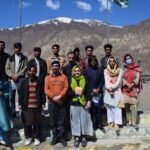1. Introduction
This report evaluates the status, challenges, and opportunities relating to the inclusion of the Overseas Gilgit-Baltistan (GB) and Chitral communities within national and international socio-economic and policy frameworks. By drawing on community feedback, diaspora organisation inputs, and Goodwill Endavours, we can assess how effectively these groups are integrated into relevant inclusion and development initiatives. The conclusions are somewhat pessimistic.
2. Background
The people of Gilgit-Baltistan and Chitral have a long tradition of overseas migration, with communities established in the Gulf States, Europe, and North America. These diaspora members contribute significantly to local economies through remittances, social investment, and skill transfer. However, despite their contributions, many feel underrepresented in national diaspora policies and platforms, leading to greater concerns about inclusion, recognition, and support.
3. Objectives
- To evaluate the level of institutional and policy inclusion of Overseas GB and Chitral communities.
- To identify barriers to equitable participation in national diaspora programs.
- To recommend policy and programmatic measures to enhance engagement and inclusion.
4. Methodology
Period – 2020 to 2025
- Data Collection: Surveys, key informant interviews, focus group discussions, and policy document reviews.
- Geographical Scope: Middle East, UK, USA, and select EU countries with notable GB and Chitral diaspora populations.
- Stakeholders Consulted: Overseas community organisations, government representatives, NGOs, and youth/women groups.
5. Key Facts
Key Facts: Limited Diaspora Contribution to Disability Inclusion in Gilgit-Baltistan and Chitral
5.1 Overview
While the Overseas Gilgit-Baltistan and Chitral (GB&C) diaspora has made significant contributions in education, health, and infrastructure, its role in advancing disability inclusion remains underdeveloped and largely overlooked. The diaspora’s investments and philanthropic activities have seldom prioritised the rights, empowerment, or accessibility needs of persons with disabilities (PWDs) in Pakistan.
5.2 Lack of Targeted Initiatives
- Minimal Inclusion in Diaspora Agendas: Most overseas community organisations focus on education scholarships, cultural events, or emergency relief, but none maintain structured programs for disability inclusion or rehabilitation.
- Charitable, Not Developmental Approach: When disability-related aid is provided, it tends to be charity-oriented (wheelchairs, medical support) rather than rights-based or capacity-building, thus failing to create long-term empowerment.
- Absence of Policy Advocacy: Despite strong social media networks and political engagement, overseas GB&C groups have not leveraged their influence to advocate for government reforms on disability inclusion or accessibility in their home regions.
5.3 Funding and Resource Allocation Gaps
- Diaspora fundraising campaigns and remittances are often directed toward visible community infrastructure (mosques, schools, roads), with little or no allocation for inclusive infrastructure such as accessible buildings, assistive technologies, or inclusive education centres.
- Disability NGOs in GB and Chitral report low engagement from overseas donors, even though the diaspora has a substantial potential to mobilize resources for inclusive initiatives.
- There is no dedicated diaspora trust or fund to support the economic empowerment of PWDs, despite rising unemployment and a lack of vocational training in these regions.
5.4 Weak Collaboration with Local Disability Organisations
- Overseas associations rarely coordinate with local disability-focused groups such as community-based rehabilitation (CBR) centres or special education schools in GB and Chitral.
- This disconnect has resulted in missed opportunities to enhance local expertise, share global best practices, or implement joint programs.
- A lack of institutional partnerships between diaspora networks and local NGOs has hindered knowledge transfer and innovation in disability inclusion.
5.5 Social and Cultural Barriers within the Diaspora
- Cultural stigma around disability remains prevalent within parts of the overseas GB&C community, leading to silence or invisibility of disabled persons in community events and leadership structures.
- There is limited awareness among overseas youth and professionals about the social model of disability or international disability rights frameworks such as the UNCRPD (United Nations Convention on the Rights of Persons with Disabilities).
- The prevailing perception of disability as a matter of personal misfortune or charity, rather than equality and rights, continues to shape community attitudes.
5.6 Impact on Disability Development in GB and Chitral
- The lack of diaspora engagement has slowed inclusive development in GB and Chitral.
- Local disability initiatives remain underfunded and isolated, with minimal international partnerships or technical support.
- Overseas professionals from these regions—many of whom are active in medicine, education, and business—have not yet mainstreamed disability inclusion into their development or CSR efforts.
- Consequently, the diaspora’s influence, while significant in other development sectors, has not translated into measurable gains for persons with disabilities.

